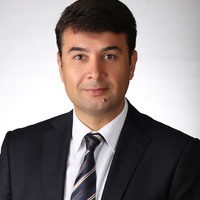
Paolo Follesa
Related Authors
David Costalago
University of British Columbia
Chunbo Shao
Johns Hopkins University
Bernard M Levinson
University of Minnesota
Cees van Westen
University of Twente, Faculty of Geoinformation Science and Earth Observation (ITC)
Greg Tolley
Florida Gulf Coast University
Viacheslav Kuleshov
Stockholm University
Bashkim Idrizi
University of Prishtina
Milton L. Asmus
FURG - Universidade Federal do Rio Grande
Taskin Kavzoglu
Gebze Technical University
Prof. Dr. Rasime Kalkan
European University of Lefke








Uploads
Papers by Paolo Follesa
functional properties in the physiological and pharmacological modulation of neuronal excitability. It has been suggested that changes in the gene expression of GABAARs represent one of the mechanisms implicated in the development of tolerance to and dependence on GABAergic drugs. Moreover, expression of specific GABAAR subunit genes is affected by endogenous modulators of receptor function such as neuroactive steroids and may contribute to the pathophysiology of anxiety disorders. This effect of steroids appears to be mediated through modulation of GABAAR signaling mechanisms that control the expression of specific receptor subunit genes. Neuroactive steroids might thus exert differential effects on GABAAR plasticity in distinct neuronal cell populations. In order to gain more information about the molecular mechanisms by which GABAergic drugs can produce plastic changes of the GABAARs, we have used a simple experimental model of neurons in culture that express most of the GABAAR subunits that are assembled in functional receptors. Here we summarize experimental data obtained with these cells in culture that show how chronic treatments with different positive modulators regulate both the expression and function of GABAARs. The understanding of these molecular mechanisms not only will provide new insights about the pathophysiology of those diseases, such as anxiety, in which GABAergic transmission plays a pivotal role, but will prove to be important to develop and design new anxiolytic, hypnotic and anticonvulsant selective drugs devoid of side effects.
functional properties in the physiological and pharmacological modulation of neuronal excitability. It has been suggested that changes in the gene expression of GABAARs represent one of the mechanisms implicated in the development of tolerance to and dependence on GABAergic drugs. Moreover, expression of specific GABAAR subunit genes is affected by endogenous modulators of receptor function such as neuroactive steroids and may contribute to the pathophysiology of anxiety disorders. This effect of steroids appears to be mediated through modulation of GABAAR signaling mechanisms that control the expression of specific receptor subunit genes. Neuroactive steroids might thus exert differential effects on GABAAR plasticity in distinct neuronal cell populations. In order to gain more information about the molecular mechanisms by which GABAergic drugs can produce plastic changes of the GABAARs, we have used a simple experimental model of neurons in culture that express most of the GABAAR subunits that are assembled in functional receptors. Here we summarize experimental data obtained with these cells in culture that show how chronic treatments with different positive modulators regulate both the expression and function of GABAARs. The understanding of these molecular mechanisms not only will provide new insights about the pathophysiology of those diseases, such as anxiety, in which GABAergic transmission plays a pivotal role, but will prove to be important to develop and design new anxiolytic, hypnotic and anticonvulsant selective drugs devoid of side effects.